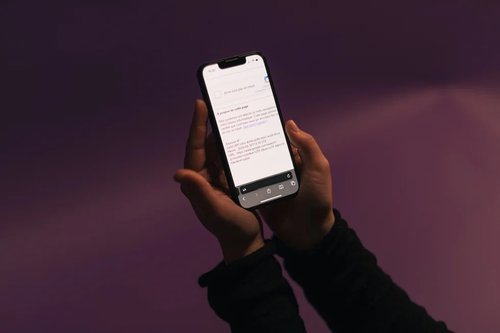How productive are you, really? Unlocking productivity in the workplace
Apr 03, 2024
6 mins


US Editor at Welcome to the Jungle
Ever feel like the 9-to-5 is a farce? Whoever really works a straight 8 hours? A typical eight-hour workday is rarely just about work. There are lunch breaks, water cooler chats, checking social media, and, of course, many pointless meetings that could have just been emailed. For those at home, it might also include household tasks like doing laundry, walking the dog, or spending time with family. These activities blend into our working hours, but by how much?
A 2023 Blind survey revealed that about 45% of workers, including those at major tech companies like Amazon, Microsoft, and Google, reported working four hours or less daily. This finding was echoed in a similar study by Zippia, which found that during an eight-hour workday, the average worker is actively working for only about four hours and twelve minutes. This research suggests that the actual time spent working might be significantly less than the traditional eight-hour workday, with factors like internet browsing and social media usage contributing to reduced active work hours.
While the findings from the Blind and Zippia studies offer valuable insights into worker productivity, it’s important to consider the nuances in these self-assessed studies. Self-assessment can often lead to subjective interpretations of productivity, influenced by individual perceptions and work environments. Measuring worker productivity is more complex and nuanced than simply tallying hours worked or tasks completed. So, how productive are we, really? And, when we perceive our days as filled with procrastination, how can we enhance our productivity?
So, are we really that unproductive?
It turns out productivity can’t be pigeonholed into a one-size-fits-all definition. “Productivity can be an imprecise concept—perceptions of productivity may depend on the design of the job and the mindset of the individual doing it,” explains B. Alan Echtenkamp, PhD, an organizational psychologist with 30 years of experience helping leaders create high-performing teams and the founder of Slingshot Leadership.
A scientific article published on IZA World of Labor analyzed worker productivity studies and found that traditional productivity measures, such as labor productivity, value-added per worker, and wages, often fail to accurately reflect individual worker productivity. These measures are either too broad or influenced by factors like age, tenure, discrimination, and labor market conditions, which do not directly correlate with actual productivity.
Why do we feel so unproductive all the time?
So, if it’s hard to measure productivity, why do we always feel so unproductive? “People sometimes conflate productivity with activity—if you’re not visibly doing something, the perception is you’re not being productive,” explains Dr. Echtenkamp. “I believe there are misconceptions about both how productivity should be defined and which inputs contribute to it,” he adds.
Social media serves as a prime example of this disconnect, he explains. “The way people appear on these platforms isn’t always a true reflection of their real selves, which can lead to misunderstandings.” He adds, “Our insecurities around [productivity] may stem from not comparing our experiences against a realistic standard. We’re not reality-testing ourselves against a true measure of what’s normal or expected.”
Like the respondents in the Zippia and Blind surveys, we sometimes think our procrastination and lack of deep focus indicate unproductiveness. For example, have you ever caught yourself daydreaming and thought you had just wasted 20 minutes? Well, Dr. Echtenkamp says that may also be useful. “Research supports the notion that engaging our brain’s default network, through things like daydreaming may benefit cognition and ideation.”
The notion that non-stop work equals greater productivity is likely a misconception about human functionality, Dr. Echtenkamp explains. UC Berkeley’s Greater Good Science Center study, referencing K. Anders Ericsson’s research, reveals that top performers, like elite violinists, not only practice intensively but also prioritize rest, distinguishing them from their less accomplished counterparts. This shows that optimal productivity involves balancing dedicated work with adequate rest. So, those 20-minute daydreaming sessions are a great way to recharge—it’s a form of productivity.
In essence, we’re probably more productive than we think. “When you define productivity in economic terms, it seems that people are generally productive. The GDP is growing, and the economy is thriving overall. So, in economic terms, people are performing effectively for their organizations,” explains Dr. Echtenkamp. “The more interesting question to me is, ‘Are organizations performing effectively for their people?’ We should be defining productivity in a way that accomplishes the business priorities of the organization and allows people to have a sense of purpose, community, and accomplishment in the work they do,” he says. “As Alice Waters wisely noted, ‘Work can be hard, but it should never be meaningless.’”
Why are companies so obsessed with productivity?
KPIs, revenue, and client satisfaction are only a few ways companies track workers’ productivity. This obsession stems from the need to ensure that business operations are efficient with minimized costs and maximized profits. “Companies want to feel like they’re getting their money’s worth,” says Daniel Wiegert, PhD, SPHR, SHRM-SCP, an experienced Organizational Consultant and founder of Big Sky Psychological Coaching.
“When companies refer to employees as being ‘unproductive’, what does that actually mean for the organization?” he questions. Often, organizations seize upon the term ‘unproductive’ as an indicator that they might be able to extract more output from their employees, he says. “They see it as an opportunity to enhance efficiency and increase output, believing there is untapped potential in the workforce.”
However, Dr. Wiegert says there are other ways to improve productivity. He gives an anecdote to explain: “In Montana, there’s a joke that the opening day of hunting season should be a holiday, as few are keen to work then. This illustrates a point about productivity: why compel an employee to work when they’d rather be elsewhere, like hunting? A good leader might recognize this and offer them the day off, allowing them to catch up on work later when they’re more focused.”
How can workers be more productive?
Sometimes you may underestimate your productivity, not realizing that you are, indeed, accomplishing more than you think. On other occasions, your perception could be correct, and you’re genuinely not being as productive, potentially falling into periods of inactivity or slacking. Whether you are a self-assessed procrastinator or your company is hyper-focused on productivity measures, you can do a few things to bring some pep to your step.
Understanding the root cause of productivity issues is key to addressing them, explains Dr. Echtenkamp. For instance, poor performance might be due to a lack of interest, signaling a motivational issue. Alternatively, it could result from unclear job responsibilities or insufficient expertise. In contrast, someone might be keen and knowledgeable about their duties but lack the necessary skills. Dr. Echtenkamp says the solutions vary accordingly: skill enhancement is needed when there’s eagerness without know-how, while motivational strategies are required for those who understand and are capable of their role but lack interest. Identifying the specific cause will help determine the right approach for improving productivity.
Dr. Wiegert suggests mindfulness: “It’s such a buzzword now, but people are usually doing it wrong,” he says. For instance, lack of productivity can stem from stress. He adds, “Stress often stems from worrying about past events or fearing future ones. Focus on being present in the moment.” If it’s in the past, learn and move on, he says, remembering that others likely won’t dwell on your mistakes. Mindfulness is about concentrating on the task at hand and setting manageable goals.
Time management is also important. As noted by UC Berkeley, K. Anders Ericsson’s research might hold some help. Violinists destined to become professional soloists practiced an average of 3.5 hours daily, typically in three separate sessions of 60-90 minutes each. In contrast, good but not great performers typically practiced an average of 1.4 hours per day, with no deliberate rest breaking up their practice sessions. Furthermore, the top violinists slept more than their less-accomplished classmates by an hour a night. They were also far more likely to nap—nearly three hours a week between practice sessions. So schedule those breaks, and don’t feel guilty!
Are flexible schedules the answer to increased productivity?
Suppose you want to follow Ericsson’s research and take that 30-minute power nap. How are you going to squeeze that in? Block out your calendar to ‘do not disturb, I’m napping’? Probably not. However, flexible schedules that allow you scheduled breaks or time off to concentrate on other activities might. For example, getting lunch with your friends or picking the kids up from school every afternoon. These activities can help us break up our day and recharge for productivity when it matters.
Tyler Sellhorn, who has been head of remote for two global tech firms and host of “The Remote Show” podcast, says we need a more human-centered workplace model to increase productivity. “Some people will work very well inside an office and should be provided one. Other people would like being physically close to the requirements of daily life,” he shares.
Adapting organizational structures and redefining how employee productivity is measured is necessary. “For example, being present in a building and swiping a badge doesn’t necessarily mean being productive,” Sellhorn adds. For example, if we aim for productive thinking hours, we must look beyond being physically present in an office. He says we should measure productivity by work output, not just by physical presence or input.
Giving workers more agency
In hierarchical organizations, a strong emphasis is typically placed on physical presence and adherence to conventional working styles. Moreover, Sellhorn points out that when employees have more control over their work, it encourages innovation and creativity. This environment, where team members feel a sense of ownership over their work, is conducive to experimentation and the development of new, efficient methods of working. “I think fundamentally, the shift towards more flexible working arrangements works best when managers have embraced the idea that sharing power and investing power among others leads to a more productive team and individuals,” he says.
The future of productivity
In a world reshaped by Covid-19 and propelled forward by technology, the conventional 9-to-5 workday teeters on the brink of obsolescence. It’s a far cry from the days of Henry Ford’s assembly lines, and we’re left pondering whether this old-fashioned system is a relic of the past or can evolve to fit our flexible, tech-driven future. The future of work calls for a shift in mindset, where flexibility, innovation, and results take precedence over rigid schedules. It’s a paradigm shift that challenges our preconceptions and offers the potential for a more productive and fulfilling work-life balance. Instead of counting hours, let’s focus on outcomes and impact.
Photo: Welcome to the Jungle
Follow Welcome to the Jungle on Facebook, LinkedIn, and Instagram, and subscribe to our newsletter to get our latest articles every week!

More inspiration: Productivity & tools

Goal setting: How to bounce back when you feel like a failure
The big F word ... Failure. We all face it, but here’s how to make it your secret weapon for success.
Dec 18, 2024

Productivity boost: Why mental health outshines long hours
Long hours don’t equal better work. Discover how mental health support can unlock productivity and time efficiency in the workplace.
Nov 28, 2024

10 fun ways people are using AI at work
While many use AI for basic tasks like grammar checks or voice assistants, others are finding innovative ways to spice up their work days.
Nov 05, 2024

12 Slack habits that drive us crazy
Slack is a top messaging platform, but coworkers can misuse it. Over-tagging and endless messages can make it frustrating ...
Oct 16, 2024

10 CareerTok creators you should be following
Looking for career advice? CareerTok has quick tips from real experts on interviews and job offers.
Sep 25, 2024
The newsletter that does the job
Want to keep up with the latest articles? Twice a week you can receive stories, jobs, and tips in your inbox.

Looking for your next job?
Over 200,000 people have found a job with Welcome to the Jungle.
Explore jobs